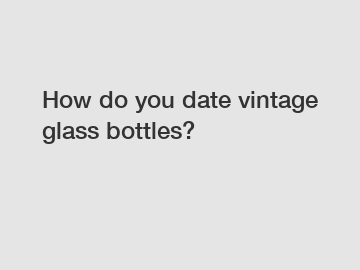How do you date vintage glass bottles?
How do you date vintage glass bottles?
Dating vintage glass bottles can be a fascinating process that involves researching various aspects of the bottle. By examining the bottle's characteristics, markings, and other identifying features, collectors and enthusiasts can gather valuable information about its age and origin. In this article, we will explore the different methods and techniques used to determine the age of vintage glass bottles, their significance, and the impact of dating them accurately.
Determining the age of a vintage glass bottle can be done through several techniques. One of the most common methods is to examine the bottle's physical characteristics. This includes scrutinizing the bottle's shape, size, and color. Generally, older bottles tend to have a distinct shape and style that reflects the manufacturing process prevalent during that era. For example, bottles from the early 19th century often had a pontil mark, which is a rough or irregular base caused by the removal of the bottle from a pontil rod during production.

Another crucial aspect to consider when dating vintage glass bottles is the presence of any markings or embossing on the bottle. These markings are usually found on the base, body, or neck of the bottle and typically indicate the manufacturer, location, or other relevant information. By researching and cross-referencing these markings with historical records and bottle catalogs, collectors can accurately date the bottle. Furthermore, changes in bottle manufacturing techniques and regulations can provide additional clues about a bottle's age, allowing for a more precise dating process.
Additionally, the type of glass used in vintage bottles can also offer valuable insights into their age. Over time, glass manufacturing techniques have evolved, resulting in variations in thickness, color, and composition. By understanding these changes and their corresponding time periods, collectors can identify the era in which the bottle was produced. For example, early hand-blown bottles tend to have a distinct greenish hue, while bottles produced in the mid-19th century may have a more uniform and clear appearance due to advancements in glass manufacturing.
Accurately dating vintage glass bottles not only provides important historical context but also has significant value to collectors and enthusiasts. Knowing the age of a bottle enhances its desirability and can affect its monetary worth. Furthermore, dating bottles allows collectors to categorize and organize their collections more effectively, fostering a deeper appreciation and understanding of the history behind each bottle. Additionally, it contributes to preserving our cultural heritage by documenting the evolution of bottle manufacturing practices over time.
In conclusion, dating vintage glass bottles involves a systematic approach that includes examining physical characteristics, researching markings, and understanding the evolution of glass manufacturing techniques. This process provides valuable information about the age and origin of the bottle and contributes to the overall appreciation of its historical significance. By accurately dating bottles, collectors and enthusiasts can enhance the value of their collections and contribute to the preservation of cultural heritage.
If you want to learn more, please visit our website custom glass spirit bottles, customized spirit glass bottle, 700ml liquor bottle.
156
0
0


Comments
All Comments (0)